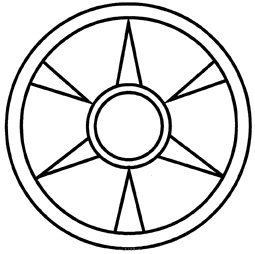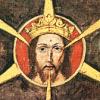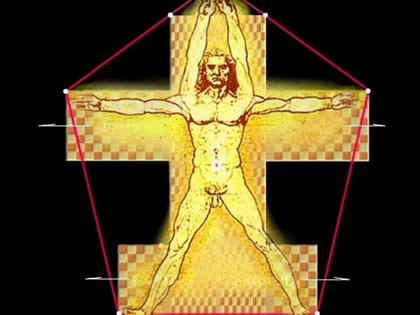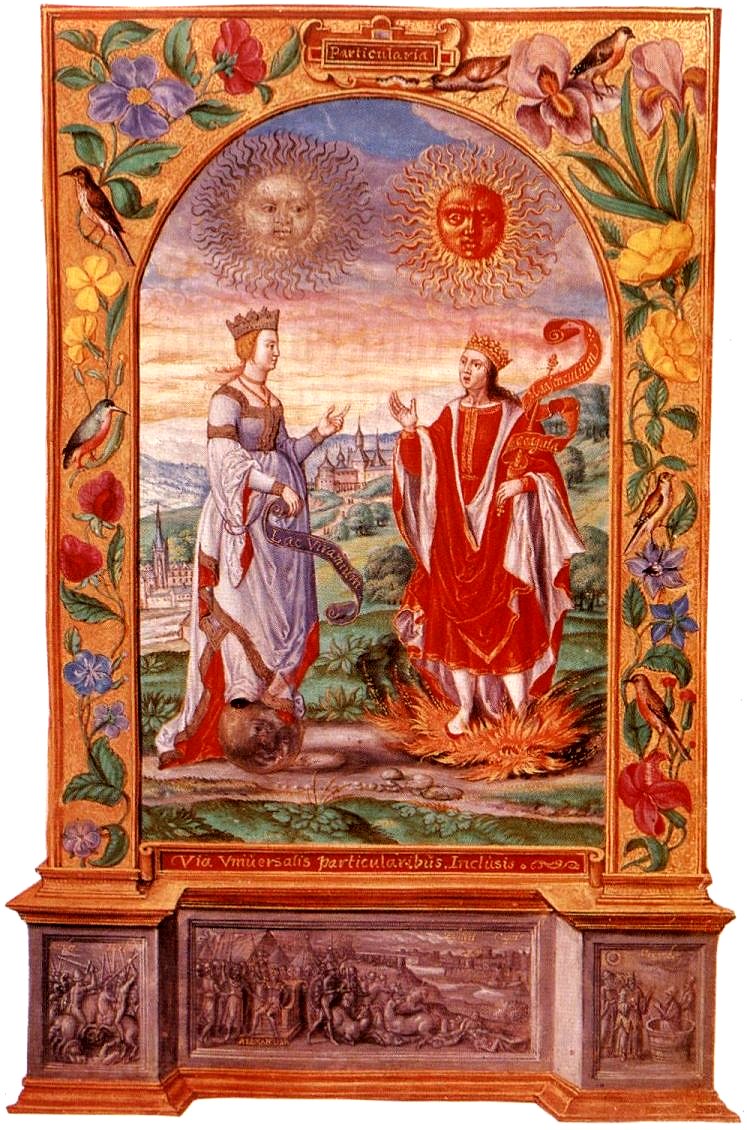|
|
Post by Goldenfleeced on Sept 3, 2013 4:00:59 GMT
In the following discussion I will sketch how this "one archetype" that appears to lie at the foundation of all the religions of our world is symbolically represented in Nicholas von Flue's wheel image. (See figure 1.) From the perspective of the psychology of religion, this wheel image corresponds to a renewed image of God in which the World Soul -- the objective psyche or the collective unconscious of C.G. Jung -- is redeemed by humankind, and along side the World Soul, the principle of synchronicity, takes the place of the Christian God. The empirical human being experiences the inner, microcosmic liberation and redemption of the divine World Soul from matter in the process of the introverted transformation of drive energies which serve in structuring the deified breath body for life after death.
[Remark of August, 2003: In the meantime I have seen that we must distinguish the macrocosmic World Soul as well as the microcosmic body soul from Carl G. Jung's collective unconscious. The latter belongs to the realm of Logos, the former to the realm of Eros. The principle of Logos we can compare with the particle aspect, the Eros with the wave aspect of the matter of physics.
As synchronicities I define today events, in which outer Logos, i.e. some sort of a "knowledge of matter", meets inner Logos, i.e. the preconscious knowledge (Jung) in an acausal way. Therefore by finding the meaning of synchronicities, we can come closer to this absolute or preconscious knowledge, and this realization leads into a much more meaningful life. This process the revolutionary depth psychologist called the individuation process.
The World Soul and the body soul, however, belong to the realm of Eros in its original meaning of connectedness, and are therefore comparable with the wave principle of quantum physics. The union of Logos and Eros, of the "particle" and the "wave", the medieval alchemists called the coniunctio, the sexual union of the divine masculine principle with the divine feminine. This union is described by the Hermetic alchemists, as for example by Paracelsus, his student Gerardus Dorneus and Robert Fludd (see The Return of the World Soul). A few years before his death, Carl G. Jung confessed that he was not yet able to understand this process. He writes to the physicist and Nobel laureate Wolfgang Pauli: "The problem of the coniunctio must be kept for the future; it is more than I can cope with, and my heart reacts if I exert myself too much along these lines." [Atom and Archetype, 2001, p. 101]paulijungunusmundus.eu/rfr/radbilde.htmI hope you don't mind too much that I lean on the previous research of others in my findings... I see it done every day on other forums, and find it to be a legitimate means of at least opening discussion along certain lines that have already been considered, at least, by other minds aside from my own. While this, in and of itself, does not prove that I am not 'mad,' it does tend to intimate that I am not alone in my madness... I seem to enjoy good company. The reason that I wish to bring this particular subject 'to the table,' so to speak, is that it is connected in some really interesting ways to the other thread subjects; the end of our little 'journey' should bring us to an understanding of just what those connections mean, and what we can expect, as a consequence. I think it's all hugely interesting, and I will continue to quote from this particular website, in the following posts. Another interpretation of the 'face' and the 'wheel'...
|
|
|
|
Post by Goldenfleeced on Sept 3, 2013 4:11:04 GMT
The Visions of the Terrible Face of God and the Wheel ImageNicholas von Flue was born in the year 1417 in Sachseln, in the vicinity of Lucerne, and died at the age of 70 in the year 1487. He claimed to have had visions already in the womb. This series of visions continued during his earthly life and concluded with the so-called vision of the terrible countenance of God. (See figure 2.) This last of Nicholas's visions known to us came to him some ten years prior to his death. According to the report of the Humanist Bovillus, the countenance carried a "terrifying expression, full of anger and threat", and consequently was early on associated with the Christ of the Apocalypse (Revelation 1:13). Above it carries a three-fold crown and below a tripartite beard. The six "sword blades without handles" that alternately pierced and exited this face appeared just as terrifying as the facial expression: One of the blades proceeded from the forehead and pointed upward; two additional pierced the eyes (and ears?); two more come out of the nose; and the last pair pierces the mouth...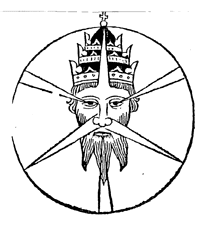
However, as I have shown in my book, Die Gottsucher, the heretical character of this vision does not only refer to the summum bonum but also to the clearly double-triadic structure of the sword blades, which are further emphasized by the double triad of crown and beard, by above and below!
Contents of the collective unconscious break into consciousness in this terrifying way only when consciousness has not yet grasped an important aspect of transformation. Viewed psychologically, we must consequently conclude that Nicholas obviously had not yet understood an important content: namely, the actual essence of the double-trinitarian aspect of the new image of God that was constellated in him which had already emerged in his earlier vision of the lily being eaten by the horse.
...The suspicion that he could fall into the hands of the Inquisition perhaps explains why he cloaked himself in silence regarding this vision much more than about the other ones13. Consequently his silence compels us to extract the knowledge concerning the renewed image of God implicit in the symbol of the wheel image with the help of C.G. Jung's amplification method.
The three sword blades directed downward penetrate the mouth and eyes, and perhaps also the ears, of the Face of God. Regarded psychologically this destruction of "God's sense organs" (!) signifies that the preconscious knowledge in the collective unconscious wants to show Nicholas that the dogmatic Christian image of God has changed and renewed itself in him: Since the outward-directed sense organs of the central nervous system are destroyed, the renewed image of God can obviously be experienced only by way of the inwardly directed vegetative nervous system. Moreover, the destruction of the sense organs is also intended to show Nicholas that in the last years of his life he must live in a state of the deepest introversion.Again, in a woodcut...  And here, with the 'point within a circle...' 
|
|
|
|
Post by Goldenfleeced on Sept 3, 2013 4:17:12 GMT
In addition I pointed out there that this renewed Deity, that ultimately corresponds to the medieval concept of the World Soul and provides compensation to the Trinitarian God of the Church Fathers reappears 450 years after Nicholas in the symbolism of quantum physics as the so-called quark-antiquark-sextet. Hence the problem confronting the medieval mystic turns out to be extremely current.
Nicholas von Flue designated the "sword blades" of the original vision as "spokes" in his wheel image. But if we orient ourselves more to the image than to the word, we see that he sketched neither spikes nor swords, but distinct lance (or sword) points. The two sets of three opposed lance points makes it immediately clear that, in his wheel image, Nicholas followed an unconscious drive in emphasizing the double-triadic aspect of the number six. By emphasizing the oppositional nature of the two triads he unconsciously but definitively broke away from the Christian Trinity and expanded it into a double trinity. Viewed structurally, this naturally corresponds to the Seal of Solomon, the emblem of the alchemists, as well as the central symbol of the heart chakra of Tantrism 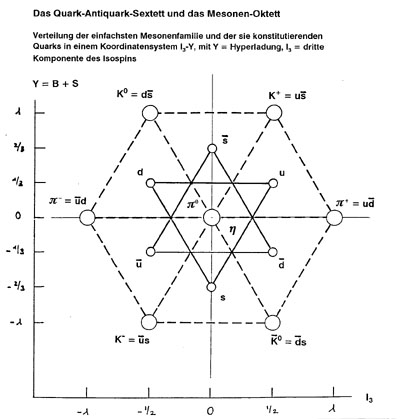
|
|
|
|
Post by Goldenfleeced on Sept 3, 2013 4:33:05 GMT
The Seal of Solomon and the Pelican of AlchemyThe Seal of Solomon (the "Star of David") symbolizes the goal of the alchemical opus. The latter consisted in transforming the purely masculine, Trinitarian God image of Christianity, represented by the upward-pointing equilateral triangle. The alchemists sensed that the Church Fathers' definition of an eternally unchanging God could not be ultimate wisdom. They sensed that a transformation of the image of God had commenced in the unconscious in the course of the Christian Aeon. Consequently they came to the extremely heretical conclusion that the Christian God ages, falls ill, and dies, and descends into matter, into the human body, or into the realm of human drives. This death of God created a situation in which every single human being had to take part in the renewal of the God that had become immersed in matter [for the following see also The New Mysticism and the Life after Death].
Since Paracelsus this prima materia that was to be redeemed, transformed, or refined had likewise been imagined as trinitarian, as was the Christian God. Moreover, it turned out to be a feminine divine principle that waited in matter or in the drives on the human body for its liberation. This World Soul ardently awaited human beings to redeem her, and was represented by the downward-pointing equilateral triangle...
As a consequence of freeing and redeeming this divine feminine trinitarian principle from the human body, the divine male principle should also have transformed into a new trinity, which would have meant the definition of a renewed, upper God image. In this way the renewed upper image of God could have united in a coniunctio with the redeemed, lower trinity. This union, which corresponds to the redeemed World Soul, was expressed in the symbol of the Seal of Solomon.
|
|
|
|
Post by Goldenfleeced on Sept 3, 2013 4:40:52 GMT
The only student of Paracelsus to suspect that this most profoundly feminine principle had to be included in the renewed upper trinity was Gerhard Dorn (Dorneus). He suggests a continuation of the alchemical opus that was to begin with what he called the unio mentalis. The unio mentalis signifies a union of spirit and psyche - he calls them animus and anima. In order to achieve this union, however, the body must first be "mortified" or "mummified." In our psychological parlance we would express this notion by saying that the body, moved by the drives and by compulsions, must be deliberately quieted, a demand lying at the foundation of every serious form of meditation and imagination. C.G. Jung's Active Imagination is a modern form of this unio mentalis (see C.W. 14, § 705-7).
In the second step of Dorn's opus, in what he called the unio corporalis, the unification of the unio mentalis with the previously "mortified" body was to be achieved. As a consequence of this procedure the dead body comes to life again and an exchange of attributes takes place: the body becomes psychic and the spirit-psyche becomes material...
The process of the exchange of attributes is represented by the alchemical pelican. This double bellied container has, in its upper part, two characteristic tubes that lead back into the lower part. During the process of boiling and vaporizing a liquid the pelican was tightly closed so that the vapor was conducted back into the liquid and thus condensed. This affected the so-called circular or rotary distillation, and of course it was crowned with success only when the pelican remained tightly closed. According to the alchemists' conception, this procedure brought about an ever more highly concentrated distillate, which thereby became the essence of the prima materia which, for its part, was the goal of the entire procedure.
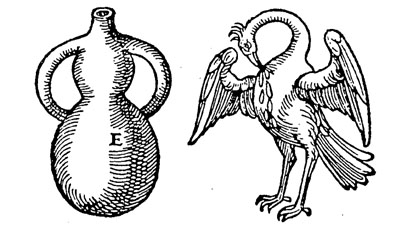 The alchemical pelican and the Christian pelican
However, the process depicted in the Pelican also corresponds to the concretization of the alchemical dictum, "Make the fixed volatile, and the volatile fixed...". In modern psychological language, this exchange of attributes refers to the phenomenon of synchronicity discovered by Jung: the relatively simultaneous appearance of meaningfully-related inner and outer events. In the phenomenon of synchronicity, a psychization of matter and a relatively simultaneous rematerialization of psyche takes place, since "psyche behaves as if it were material, or matter as if it belonged to our psyche". In the most constructive case, such synchronicities lead to a creative process in the individual.. 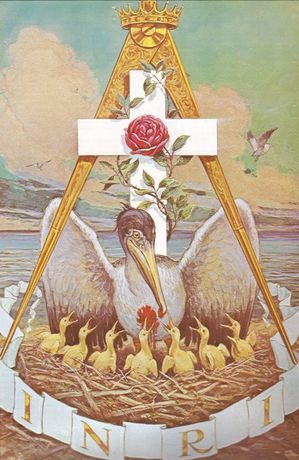
|
|
|
|
Post by Goldenfleeced on Sept 3, 2013 4:49:05 GMT
On the basis of the Christian legend of the pelican, in which the pelican rends its breast in order to awaken its dead fledglings to new life (a symbol of the lance of Longinus), it (the pelican) was also equated with the divine Heart of Jesus. Since, however, the alchemical pelican describes an eminently introverted procedure (the vas bene clausum), it follows that the heart, i.e., Eros and introversion unconditionally belong together.
If we abstract the meaning from the concrete pelican of alchemy and take it purely symbolically, we see that it describes a procedure that takes place in a completely introverted way: Taking the drives as the object of specific imagination techniques, the modern alchemist sets in motion the process of psychizing the matter of the body [yang -> yin] to which, on the basis of the synchronistic modus of this process, also belongs a parallel process of rematerializing the psyche [yin -> yang]. In this process the matter newly created by the individual [yin] in an introverted act of creation is to be understood as subtle or breath-like. It corresponds to the subtle body, created in this life for the life after death, which, in turn, is the microcosmic aspect of the redeemed World Soul. I call this modern parallel to the alchemistic coniunctio the microcosmic or inner synchronicity in order to distinguish this energetic event, observable only in the deepest introversion, from the outer-inner synchronicity Jung discovered. It corresponds to the function of introverted Eros and provides the actual counterweight to the macrocosmic, external aspect of causality related to matter (Logos).
The qualitative aspect of the number three corresponds to the concept of energy. The Seal of Solomon holds an ambivalent energy concept. In addition to physico-chemical energy (or the external, physical aspect of matter), it also contains what Jung called objective psychic energy (or inner, microcosmic, "subtle" matter), which in quantum physics reappears as the so-called "negative energy" with its peculiar properties...
...But the neglect of introversion and of Eros also carried the consequence that the two primary symbols of the alchemical opus -- the Seal of Solomon and the pelican -- could not be united in a single symbol. Granted, the Seal of Solomon has the double-triadic structure necessary for the exchange of attributes (i.e., the bipolarity of the concept of energy), but it lacks a link that can transform the one form of energy into the other. This transformation can take place only in the pelican, that is, in the human heart, and therefore only through introversion.
However, the pelican -- the symbol of the heart and of introversion -- depicts the phenomenon of the exchange of attributes, i.e., of synchronicity, but it lacks the necessary double-triadic structure (which the Seal of Solomon describes).
|
|
|
|
Post by Goldenfleeced on Sept 3, 2013 5:02:06 GMT
...Now, in revising his vision, Nicholas added to the double-trinitarian symbolism the two double circles, one inner and one on the periphery. Hence we must ask ourselves a question: What content that does not appear in the vision of the terrible countenance of God appeared so essential to Nicholas that, in the course of working on the original vision, he added to it (in the form of the double circles)?
During his vision Nicholas experienced the sensation -- which undoubtedly made him extremely anxious -- of his heart nearly bursting into tiny fragments, and he was so overwhelmed that he fell to the ground. Nicholas's psychosomatic reaction gives us the first hint that his heart was affected by the vision of the terrifying countenance of God and therefore is associated with the wheel image.
In the so-called pilgrim's tract, the anonymous pilgrim mentions that Brother Klaus had taught him to interpret the inner circle of the wheel image "as the clear mirror of the living God". In Sufism, the Moslem mystical tradition, the heart is "the mirror in which God can see Himself", and therefore it is the meeting place between the divine and the human. This agrees with the fact that in mysticism in general the place of encounter with the divine is the human heart.
In its purified condition, the Sufi's heart corresponds to the astral body (the breath body, the subtle body, the body soul, see also below), which has the ability to ascend to heaven. In order to attain its purified state, it must first be "broken" (!) and wants to run away (because it suffers unconsciously). Yet it must become "a ruin" (Brother Klaus's feeling that his heart was about to shatter into little fragments) so that the extra-divine influences in it can be destroyed. Having it out with one's drive nature is called the "uninterrupted polishing of the iron mirror of the heart", and this activity results in the Seal of Solomon in the heart.
|
|
|
|
Post by Goldenfleeced on Sept 3, 2013 5:07:44 GMT
...The three lance points are pointed to this center, that is, directed at the heart so that a three-fold piercing of the heart results. Since this heart possesses both human and divine qualities, this symbolism is reminiscent of the central motif of the Sacred Heart of Jesus mysticism, the lance of Longinus, which opens the heart of the God-Man Christ. Granted, this official Christian mysticism lacks the confrontation and coming-to-terms with the drive nature. Paracelsus in his alchemical studies made the first attempt at transformation of these instinctive energies and, as we have seen, found the suitable transformation symbol in the pelican.
According to Nicholas the outer double circle of the wheel image signifies the "visible things and the effects they evoke in us". This expression, of course, refers to the external world perceived by the five senses and their influences on our psyche. If we equate these "visible things" with the material aspect of the cosmos in general, we also include the human body and its drives. The result is that the three inward-directed lance points in the wheel image obviously are rooted in the material or bodily sphere and penetrate the heart.
By adding the two double circles to the double trinity of the original vision, a decisive shift took place in Nicholas. In contrast to the Heart of Jesus mysticism -- which denies the connection between the human-divine heart and the body and its drives and hence represses the transformation of drive energy, resulting in a sentimentalized romanticism -- Nicholas accomplishes a union of the bodily and the drive spheres with the heart.
As the examination of the pelican symbolism has shown, the word "heart" signifies a total introversion and synchronicity. Viewed psychologically, Nicholas's uniting of the drive sphere with the heart therefore means that drive energies are turned inward (introverted) so that the inner synchronistic process described above is set in motion.
With this the Swiss mystic created the necessary precondition for the introverted working through of the energetic impulses stemming from the drive triad. But at the same time -- consciously or unconsciously -- he became a Christian heretic since he was ready to acknowledge his drive nature as the prima materia of an opus in which the latter was to refined into the quintessence.
According to the statement in the vision, influences obviously proceed also from these externals, the "things of the senses," but which destroy the "sense organs" of the old image of God. A renewed image of God therefore appears to be essentially associated with a blindness, deafness and muteness in relation to the exterior, which manifestly means that the renewed Deity intends to exert no causal influence on the outer world, i.e., on that aspect of creation dependent on cause and effect.
|
|
|
|
Post by Goldenfleeced on Sept 3, 2013 5:14:26 GMT
...Further we know that during the last twenty years of his life, Nicholas did not eat anymore. It is apparent that, with the aid of the synchronistic Eros principle, the formation of the breath body had as a consequence his lack of need for any earthly nourishment in this life. His contemporaries also report that he was seen at various other places, especially at the shrine of the healing Black Madonna in Einsiedeln. In parapsychology this phenomenon is called translocation or bilocation. He himself tells that he left his body and in this way went from his hermitage to Sachseln, reminiscent of the out-of-body experiences. Nicholas is also said to have had the gift of "cardiognose", that is, he saw directly into the hearts of his fellows and was able to point out their evil deeds clairvoyantly. All these phenomena can be explained only with the aid of Jung's synchronicity principle, and they also appear in the developmental process of the Sufis and above all of the Tantricists. Therefore we shall turn to the latter in order to show that in the Christian mystic Nicholas, in addition to Moslem mysticism, Buddhist and Hindu mysticism, concerning with the formation of the breath body, was constellated, too.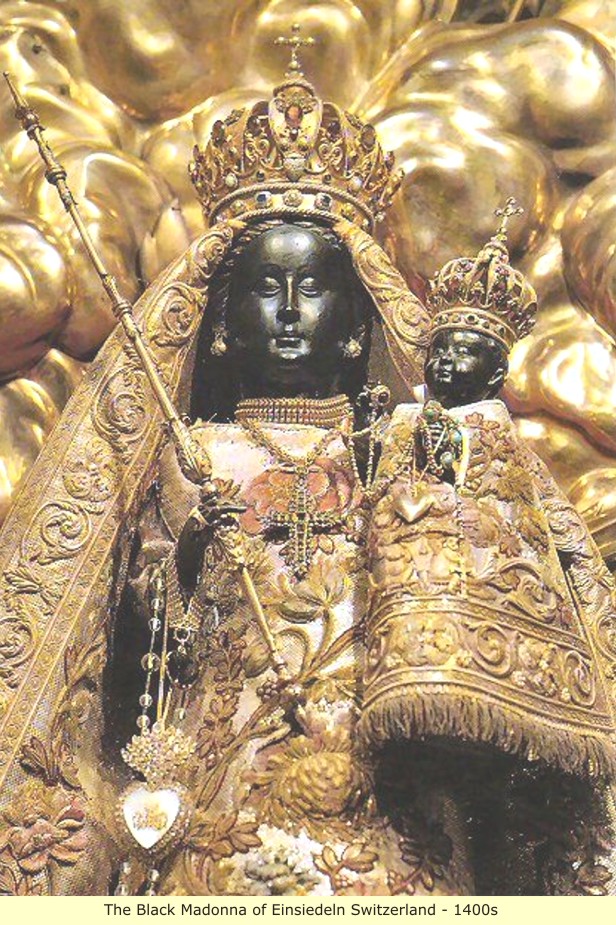
|
|
|
|
Post by Goldenfleeced on Sept 3, 2013 5:26:06 GMT
...If then, proceeding from anahata, the three upper principles are developed through a further transformation, a unification of prajna and karuna takes place, and this "is the perfect path of enlightenment." That is to say, when prajna, "the still, all-embracing, all-receiving and all-generating Eternal Feminine is joined with the dynamic-masculine principle of active compassion (karuna), the all-pervading force of active love..., then perfect Buddhahood has been attained. For understanding without feeling, knowledge without love, cognition without compassion leads to pure negation, to petrifaction, to spiritual death, to nothing but vacuum; whereas feeling without reason, love without cognition (blind love), compassion without knowledge leads to vagueness and complete disintegration. But where both strands are joined, where the great synthesis of heart and head, feeling and reason, highest love and deepest knowledge has come to pass, there wholeness is created, perfect enlightenment attained.
|
|
|
|
Post by Goldenfleeced on Sept 3, 2013 5:37:43 GMT
...This union of Eros and Logos with the aid of meditation (imaginatio) also corresponds to the goal of the alchemical opus, the creation of the incarnated God-Man in the empirical human being, which, of all Paracelsus's students, only Gerhard Dorn described, as we have seen. Following his unio corporalis, in which the inner synchronistic exchange of attributes takes place, he goes one step farther, describing the goal of the opus in the typical mythologizing language of the alchemists: After the lapis -- a synonym both of the deified breath body as well as of the renewed God image -- has been formed through the alchemical procedure, "a dark red liquid, like blood, sweats out drop by drop from their material and their vessel."
Of course we immediately think of the similarity between this process and the symbolism of the wheel image in which the three "lances" pierce the heart which is naturally associated with letting the blood of the God-Man. But also the central motif of the Sacred Heart mysticism, of Longinus's lance piercing the heart of Christ, comes immediately to mind. Yet as Jung emphasizes, this process cannot represent a return to the Sacred Heart mysticism. Because the alchemical lapis is formed through human effort and, moreover, is rooted in the realm of human instinctual drives, it cannot correspond to the historical Christ. According to Gerhard Dorn's statements, the stone sweating blood therefore symbolizes the putissimus homo, whom Jung interprets as the "most authentic" and "unfalsified" human being in contrast to Christ, who represents the homo purissimus, the pure God-Man, i.e., free from all sin. As Jung explains, Dorn's goal of the blood-sweating lapis has to do with the God-Man of the future incarnated in the very ordinary human being, the alchemical Servator cosmi or Salvator macrocosmi, who shall come at the beginning of the apocalyptic period and "who shall bring about what the sacrificial death of Christ has obviously left unfinished, namely the deliverance of the world from evil."
A 'true man'... a Truman... now, that's interesting...
|
|
|
|
Post by ayraman on Sept 3, 2013 5:43:15 GMT
|
|
|
|
Post by Goldenfleeced on Sept 3, 2013 5:47:31 GMT
I'm glad you approve... Did I miss anything? Besides the obvious...  |
|
|
|
Post by ayraman on Sept 3, 2013 6:09:29 GMT
I'm glad you approve... Did I miss anything? Besides the obvious...  That cube of the Adam Kadmon... same thing essentially. LOLOL Of course it is. Why wouldn't it be?  |
|
|
|
Post by ayraman on Sept 3, 2013 6:12:18 GMT
You hit it all very throughly gf. Like with a battleaxe. LOL Yep.  |
|
